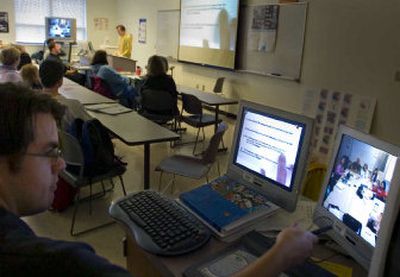Money & mortarboards

A new study suggests that the performance of colleges and universities doesn’t have that much to do with how much money they get.
And it uses Washington’s system of community colleges to make its point.
Washington spends significantly less per community college student than Pennsylvania, the study’s authors say – and yet it awards more credentials, puts more of its money toward scholarships and prepares more students for four-year schools than Pennsylvania.
Gary Livingston, chancellor of the Community Colleges of Spokane, said the fact that Washington has an overall system that coordinates colleges is a big reason for that.
“This statewide system is one of the most effective I’ve seen,” Livingston said Thursday.
Similar differences between funding and performance played out all through the new study, which examined higher education in all 50 states and at all levels.
“We found very little, if any, correlation between funding levels – and this includes both state funding and tuition – and performance,” said Patrick Kelly, a co-author of the study and senior associate at the National Center for Higher Education Management Systems, a Colorado-based organization that performed the study.
For example, researchers compared the number of undergraduate credentials produced in each state per each 100 full-time students enrolled. It found that states like Washington and Idaho, with funding per student hovering around $10,000, performed above average in that particular category. Virginia performs similarly well – but for 50 percent more money. Alaska, meanwhile, performed much worse and spent even more.
Kelly said the study’s authors aren’t advocating for wholesale budget-slashing in state capitols. But he said colleges and universities have fallen into a “knee-jerk” reaction to cuts in state funding – for every dollar lost, raise another dollar in tuition.
While it may not be an exact dollar-to-dollar ratio, public schools in the Inland Northwest have made tuition increases as regular as homecoming. WSU’s tuition went up 7 percent this year, and it’s taking the same jump next year.
Kelly said he hopes the study prompts policy-makers to consider looking at performance measures as well as funding levels.
“We hope this doesn’t turn into a budget-slashing exercise in the states,” he said, “but truly does engage policy-makers in a more constructive conversation about performance.”
The study uses a series of measures, including graduation rates, the ability to attract research and development grants, and the ability of states to move students through the “educational pipeline” – charting progress from ninth grade through college.
The study’s authors created an index for comparison, assigning states scores, with a value of 100 indicating that a state performed at the 80th percentile. Washington’s overall index score was 95.4, 13th in the country.
Idaho’s overall index score was 34th in the nation, despite good showings in some individual categories. The state scored below average in attracting research money. It and Washington both performed below average for producing master’s and doctoral degrees, and moving students through the “educational pipeline.”
Washington had the country’s best performance among bachelor’s and master’s-granting institutions – such as Eastern Washington University – with an index of 126.5.
Kelly acknowledged that the performance measures can’t get at the issue of quality. Isn’t it possible that states producing more degrees aren’t producing more educated students?
“For issues of quality,” he said, “there’s just nothing out there (to accurately measure) and never has been.”
Another concern is the difficulty of comparing different states, given the vast differences in style and approach between schools, said Jeff Gombosky, a former state legislator who is now Eastern Washington University’s lobbyist.
“The one issue that’s difficult to get your hands around is trying to come up with a universal and impartial performance indicator for programs,” he said. “Every degree program is different.”
The study made direct comparisons between two states in various categories. When examining community colleges, it compared Washington and Pennsylvania, and concluded that “there are enough similarities between these two states’ sectors to raise questions about why levels of performance are so different.”
Pennsylvania spends $1,217 more per community college student annually than Washington, and its average faculty salary is more than $6,000 a year more.
But the system here awarded more associate’s degrees, moved a higher percentage of students through a two-year program in three years, and handed out a greater proportion of credentials in arts and sciences – a key indicator of whether students go on to four-year schools.
And Washington does this while carrying a larger load than Pennsylvania. Almost two-thirds of Washington undergraduates attend a community college; it’s less than one-third in Pennsylvania.
Livingston, the head of the CCS system, said that to some degree it’s a difference of philosophies about community colleges that leads to the variety. In states like Washington and California, community colleges are seen as key parts of the undergraduate experience and are considered integral parts of the overall system of education.
In Pennsylvania, by contrast, statewide coordination is lacking. Many in the business community were unsatisfied with training available to them, according to a review by the same organization that published the new report.
The Washington State Board for Community and Technical Colleges prepares a single overall budget for 34 schools, sets standards and establishes systemwide goals. Earl Hale, the board’s executive director, said that the board tries to strike a balance between statewide coordination and allowing local control.
“We try not to duplicate programs – only when they’re needed based on student demand,” he said.
The state’s system was created in 1967 and has evolved over the decades, said Hale, who’s been in his job for 19 years. They’ve created “centers of excellence” to concentrate areas of expertise in certain schools, and they try to target services to populations based on need.
“These are the kinds of things we have done to get the dollars where the demand is,” he said.